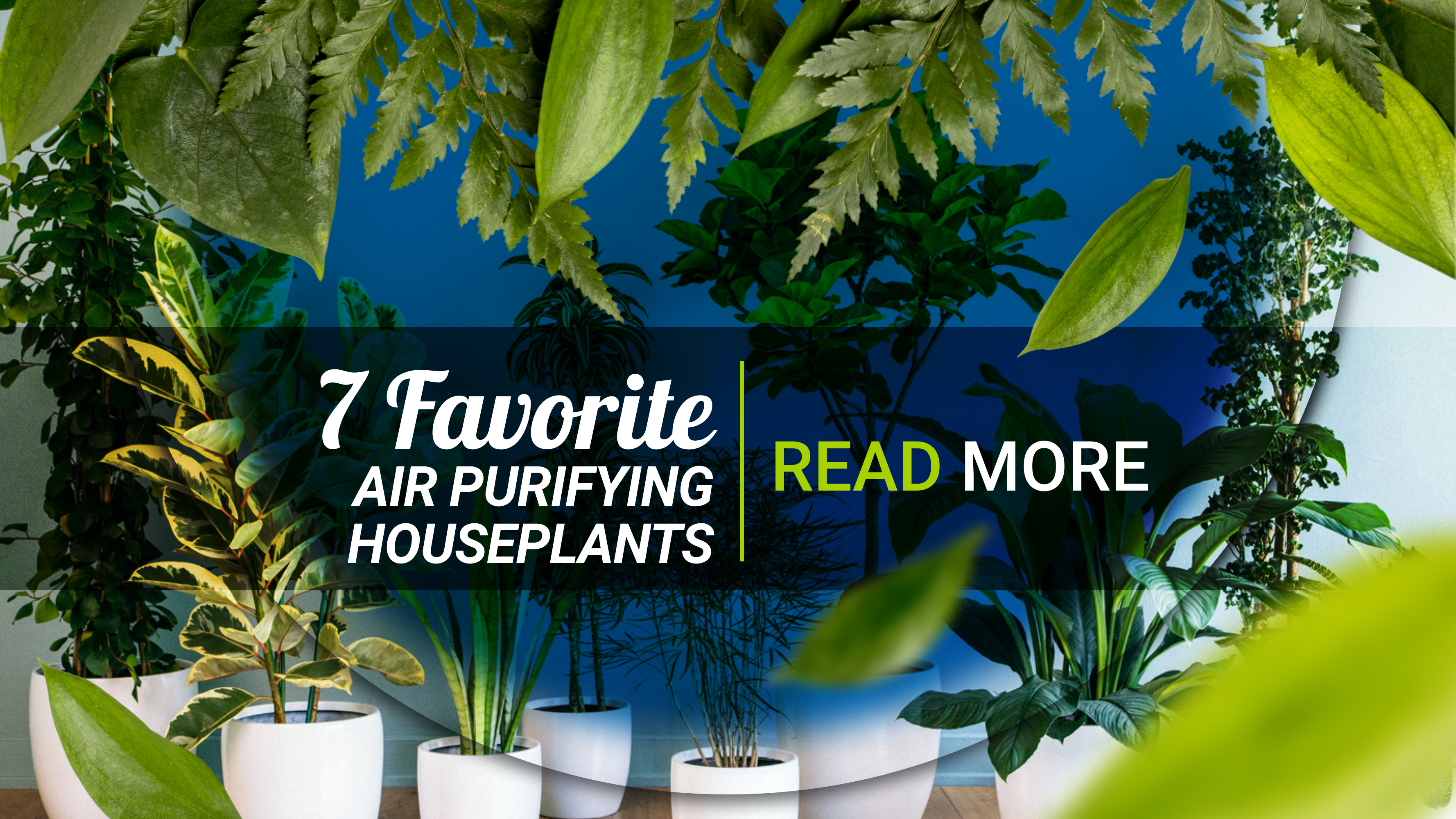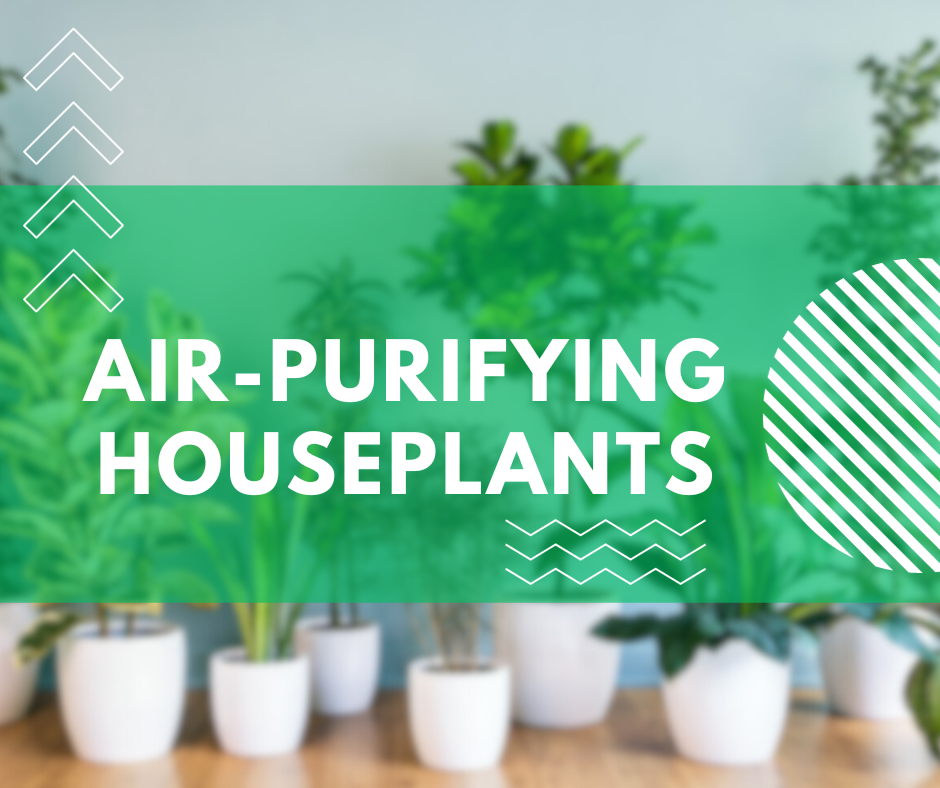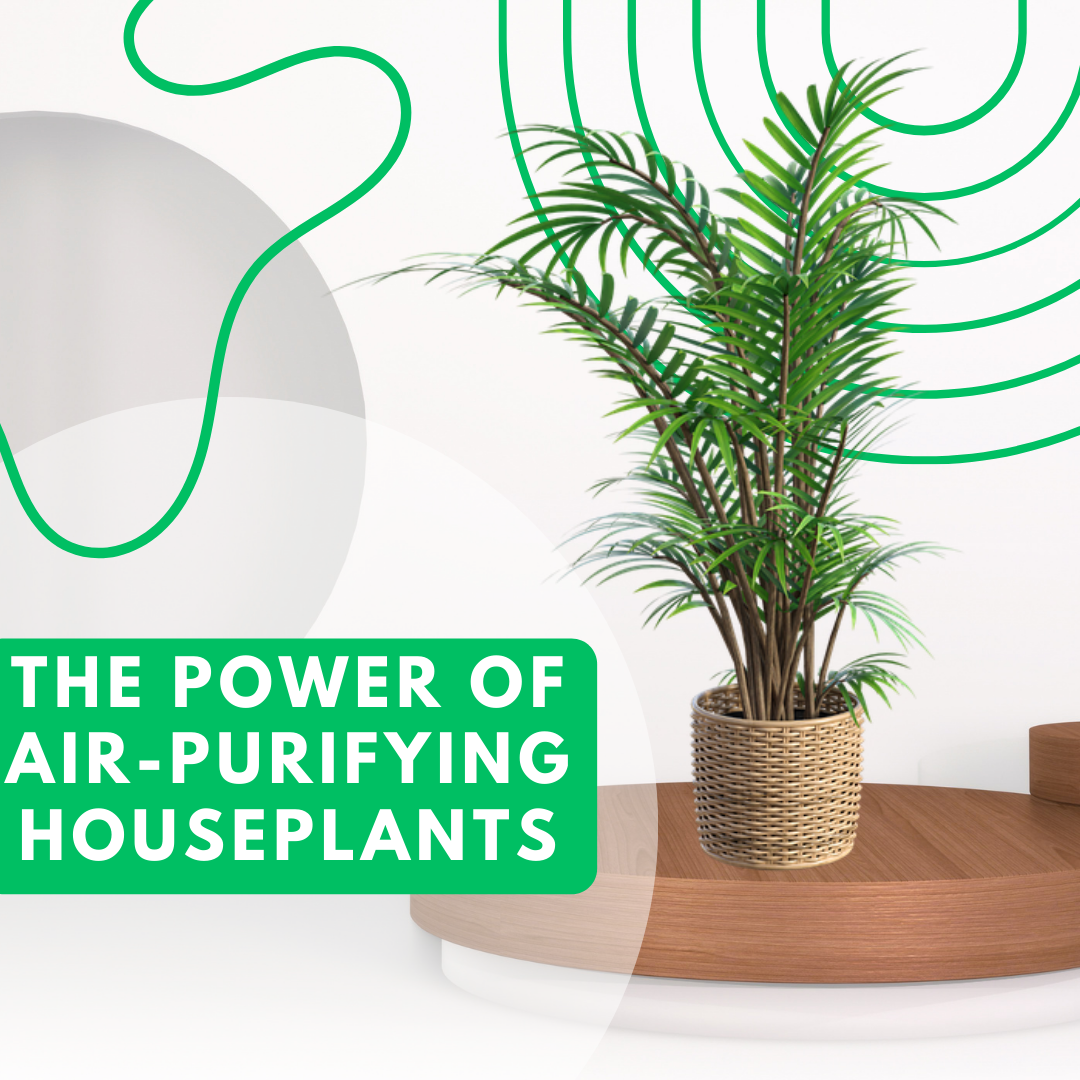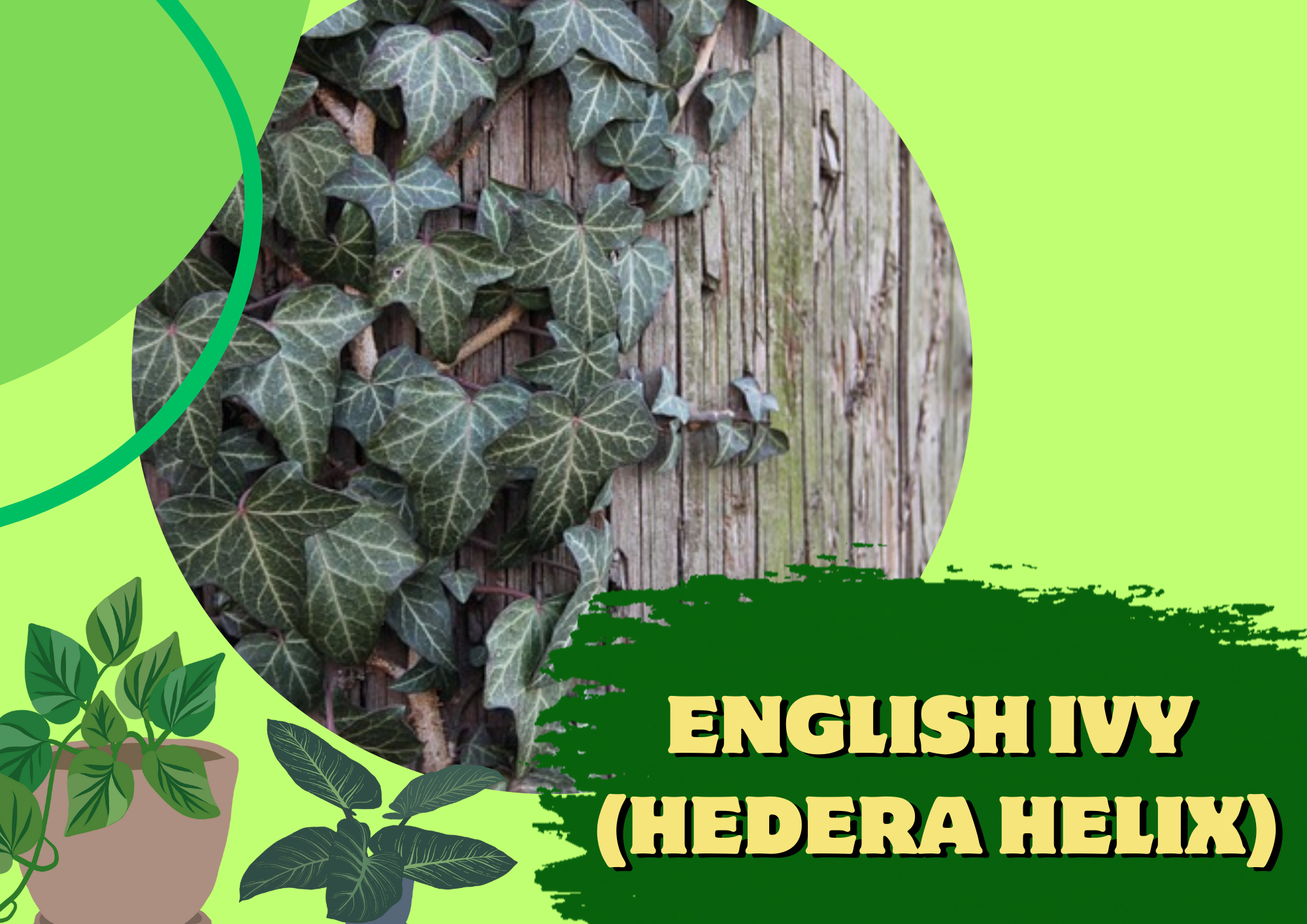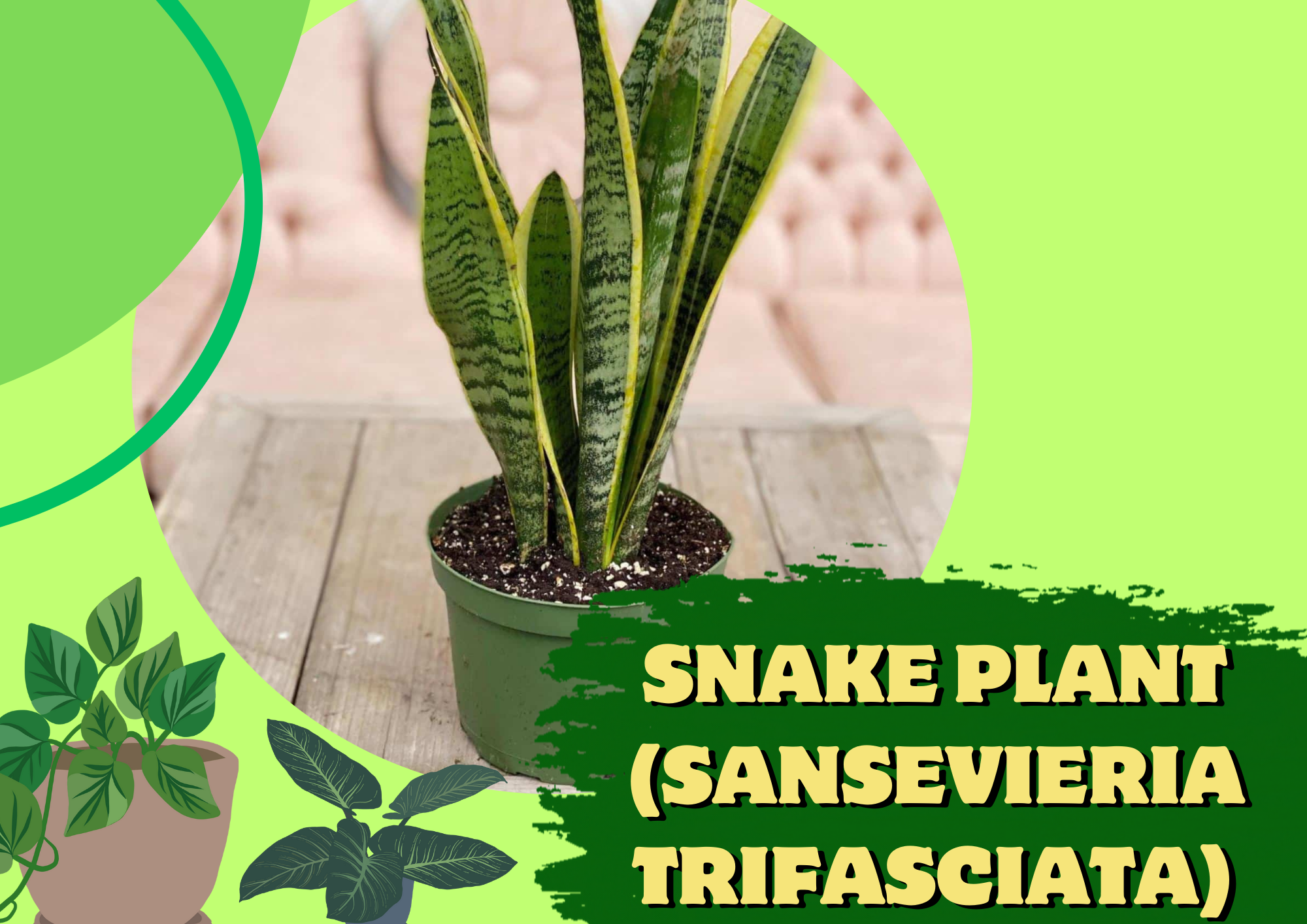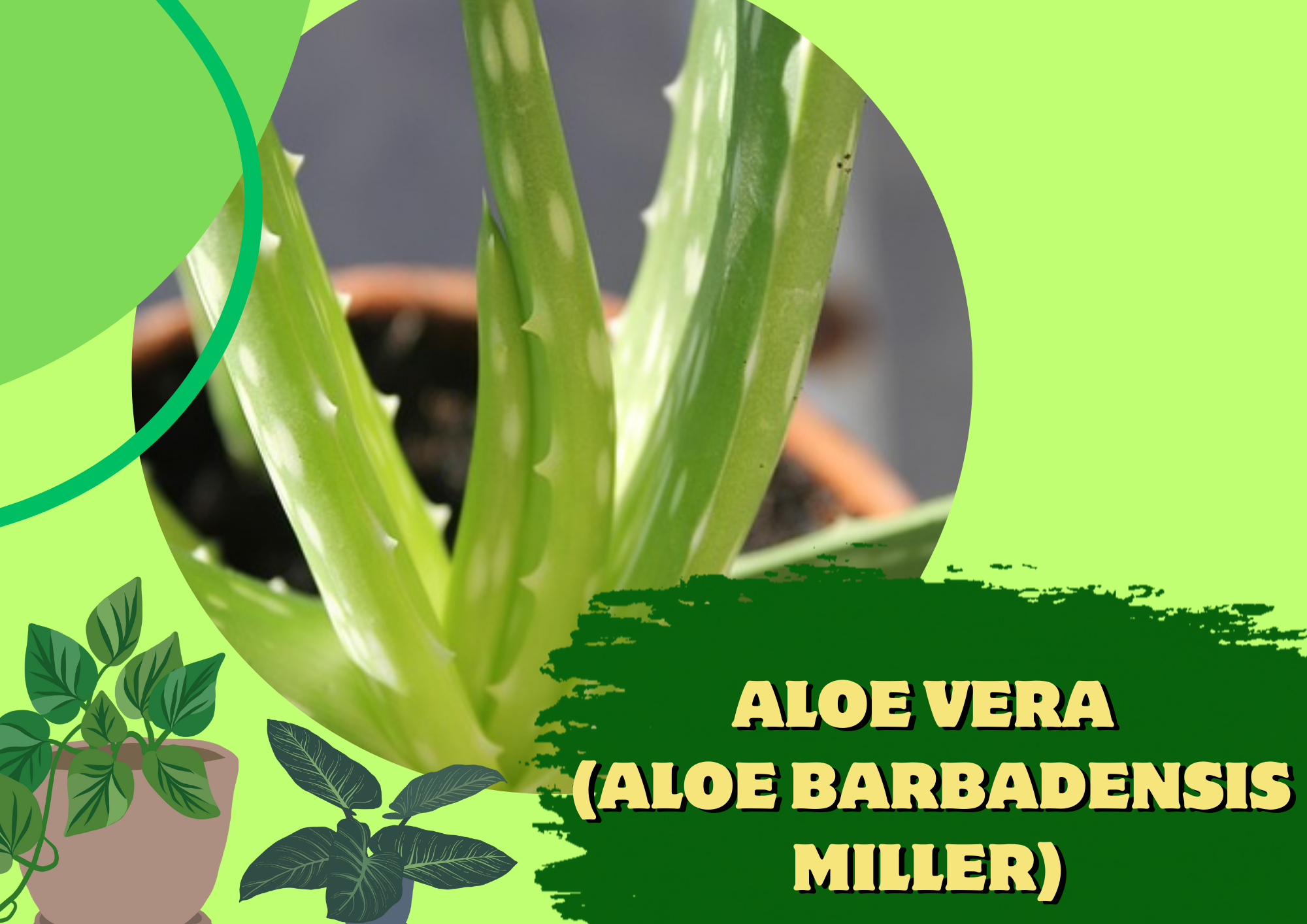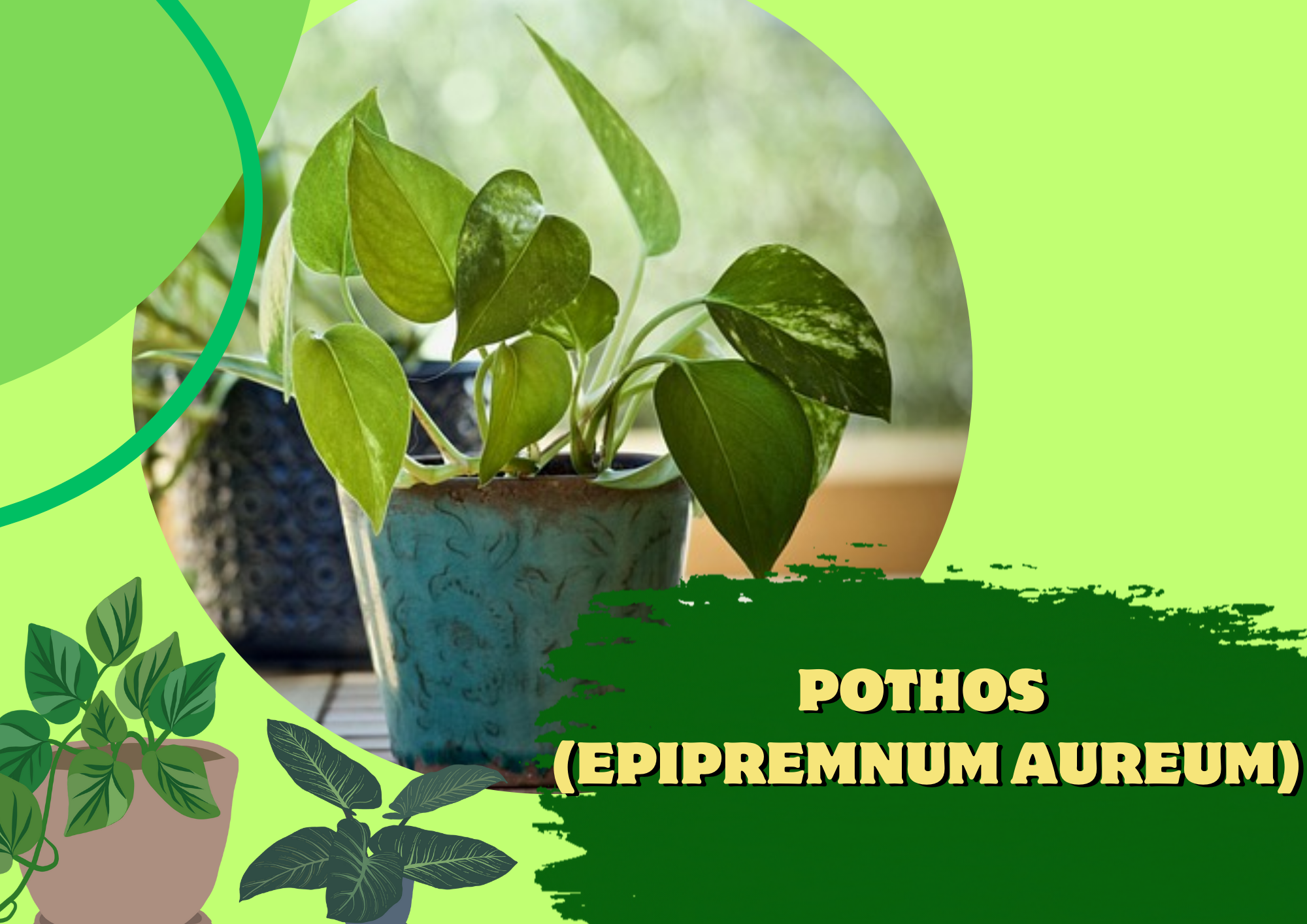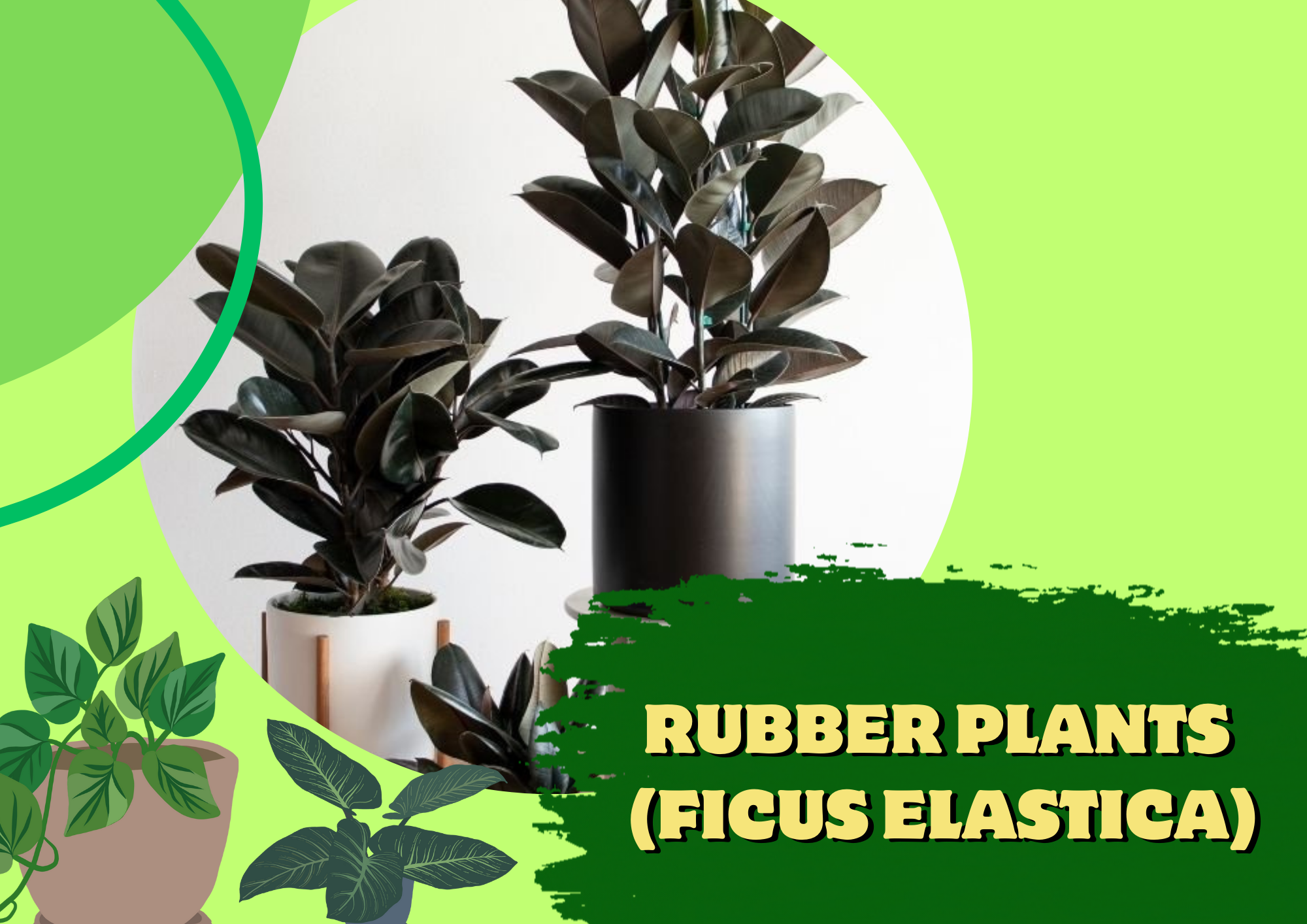HousePlantJoy is supported by our audience. When you purchase through one of our links, we may earn a small affiliate commission. As an Amazon Associate I earn from qualifying purchases. Your cost is not affected.
==================
Are you tired of the stale air in your home? Do you find yourself sneezing or coughing more often than usual? Indoor air pollution is a real problem. And it can affect your health in ways you may not even be aware of. Fortunately, there is a natural solution that can help improve the air quality in your home – air-purifying houseplants.
In this blog post, we will unveil the power of air-purifying houseplants and introduce you to the seven best plants for cleaning the air in your home.
From English Ivy to Rubber Plants, we explore their unique characteristics and care instructions so that you can choose the perfect plant for your living space. Plus, we’ll answer one of the most common questions. Do these plants work?
The Power of Air-Purifying Houseplants
Houseplants have the incredible ability to purify indoor air, improving its quality and reducing the presence of harmful toxins.
English Ivy and Spider Plant are two effective air-purifying houseplants that can be easily incorporated into your home. These plants release oxygen and absorb carbon dioxide, creating a healthy living environment.
By removing toxins like carbon monoxide, toluene, ammonia, and formaldehyde from the air, air-purifying houseplants promote clean air and a sense of well-being. Adding greenery, such as weeping figs, Chinese evergreens, palm trees, and chrysanthemums, to your living room or any other space can enhance indoor air quality and make a perfect choice for those with a green thumb.
With their natural ability to act as the most effective indoor air purifiers, these tropical plants not only beautify your home but also contribute to a healthier environment.
How Do Plants Aid in Purifying Air?
Plants play a crucial role in purifying indoor air. Through phytoremediation, they absorb pollutants like formaldehyde and benzene.
Additionally, they release moisture, increase humidity levels, and convert carbon dioxide into oxygen through photosynthesis, improving air quality.
Houseplants like peace lilies, bamboo palms, and spider plants are excellent air purifiers.
Credits:Quartz
Let’s Look at 7 Favorite Air-Purifying Houseplants
1. English Ivy (Hedera Helix)
English Ivy (Hedera helix) is a perfect choice for purifying indoor air. It reduces harmful toxins like formaldehyde, benzene, and trichloroethylene. With its dark green leaves, this trailing plant adds a touch of natural beauty to any room.
It thrives in indirect light, making it ideal for indoor spaces. English Ivy requires little attention. This makes it a low-maintenance and effective air purifier.
Unique Characteristics of English Ivy
English Ivy, known for its unique characteristics, is a versatile houseplant that thrives in various conditions. This ivy plant has white flowers that bloom during the summer months, adding beauty to any space. Not only is it forgiving and able to tolerate different environments, but it also acts as an effective indoor air purifier, removing harmful toxins like benzene.
Whether placed in bright or low light, English Ivy will flourish, making it a perfect choice for any room. Its trailing vines can be grown in a hanging basket, creating a cascading green display.
Care Instructions for English Ivy
To ensure the health and vitality of your English Ivy, you can follow these care instructions. Place the plant near a sunny spot in your home to provide it with the partial sunlight it prefers. Water moderately and allow the soil to dry out between waterings slightlywater tra. Maintain high humidity levels by misting the leaves or placing a tray of water nearby.
Monthly fertilization will promote healthy growth. And regular pruning will help control the trailing vines and maintain a compact shape.
2. Spider Plant (Chlorophytum Comosum)
Spider plants, also known as Chlorophytum Comosum, are perfect choices for indoor air purification. These tropical plants effectively remove toxins like formaldehyde and xylene, ensuring clean air in your living spaces. With their green and white striped leaves, spider plants add a touch of natural beauty to any room.
They are low-light houseplants, making them ideal for brightening up indoor spaces with indirect light. Spider plants are forgiving and require minimal plant care. Thus, they are suitable for beginners or those with a busy lifestyle. You can improve indoor air quality with these most effective indoor air-purifying houseplants.
Unique Characteristics of Spider Plants
Spider plants are known for their unique characteristics that make them a popular choice among indoor plant enthusiasts. One of their distinctive features is the production of small white flowers, which adds an elegant touch to the overall appearance of the plant.
These plants are also well-suited to low-light conditions, thriving in indirect sunlight. With their high moisture requirements, spider plants flourish in high-humidity environments. Their cascading leaves create a graceful cascading effect. This makes them a perfect choice for adding a touch of natural beauty to any room.
Care Instructions for Spider Plants
Spider plants thrive in bright, indirect light, making them a perfect choice for placing near a sunny window. To keep the plant healthy, water it when the soil feels dry. But be careful not to overwater.
Additionally, maintaining a humidity level of around 40-50% is essential. Fertilize spider plants every few months to encourage growth and green foliage. Propagating spider plants is also accessible by planting their spiderettes in moist soil.
3. Boston Fern (Nephrolepis Exaltata)
Boston Fern (Nephrolepis Exaltata) is a popular choice for indoor air purification. It effectively removes pollutants like formaldehyde and xylene from the air, ensuring clean and fresh indoor spaces. This tropical plant also acts as a natural humidifier, increasing moisture levels in dry environments. With its low-maintenance requirements, including indirect, bright light and consistent moisture,
Boston Fern is a perfect choice for any room. It’s non-toxic to pets. Thus, it’s safe for households with furry friends. Add a touch of greenery and enjoy the benefits of natural air purification with Boston Fern.
Unique Characteristics of Boston Fern
Boston Fern stands out for its air-purifying capabilities. It effectively eliminates formaldehyde and xylene pollutants from the air. Thriving in bright but indirect light and humid environments, this low-maintenance plant features unique fronds that appeal visually to any room.
Its pet-friendly nature makes it a safe choice for households with pets and children. Additionally, Boston Fern reduces dust and increases humidity, improving indoor air quality.
Care Instructions for Boston Fern
To ensure the health and vitality of your Boston Fern, it is essential to provide proper care. These plants thrive in bright, indirect light, so place them near a window without direct sunlight. Keep the soil consistently moist. But avoid overwatering as it can lead to root rot. Boston Ferns prefer high humidity levels, so consider using a humidifier or placing a tray of water nearby.
Feed them a balanced liquid fertilizer every two weeks during the growing season. Prune any dead or yellowing fronds to maintain their vibrant appearance. Repot annually in a slightly larger container with fresh potting soil to allow for growth.
4. Snake Plant (Sansevieria Trifasciata)
Snake plants, also known as Sansevieria Trifasciata, are a perfect choice for air purification. These tropical plants are highly effective in removing toxins such as formaldehyde, benzene, and trichloroethylene from the air. They contribute to clean and healthy indoor environments.
With their tall, upright leaves, snake plants add elegance to any room, making them a popular choice for brightening up living spaces. Additionally, they are low-maintenance and forgiving. This makes them great options for beginners with or without a green thumb. Snake plants are especially beneficial for bedrooms, as they release oxygen at night, improving air quality while you sleep.
Unique Characteristics of Snake Plants
Snake plants have long sword-like leaves that are often dark green with light green patterns. These plants thrive in low-light conditions. This makes them perfect for indoor spaces such as homes or offices.
Snake plants are not only aesthetically pleasing but also great air-purifying houseplants, effectively removing toxins and pollutants from the indoor air. They are low-maintenance plants, requiring little water and attention, and can tolerate various conditions, including low humidity and dry soil.
Care Instructions for Snake Plants
Snake plants are an ideal choice for those who want a low-maintenance houseplant. These plants require little water, making them easy to care for. They thrive in indirect light, making them a perfect addition to any room without direct sunlight.
Snake plants not only add a touch of green to your space but also act as effective air purifiers. They remove toxins like formaldehyde and benzene from the air. With their forgiving nature, snake plants are a great option for beginners looking to add a tropical plant to their home.
Enhance the beauty of your air-purifying indoor garden with a wide range of stylish planters and pots. Elevate your plant decor while providing the perfect homes for your green companions. Discover the perfect blend of design and functionality. #ads #commissionsearned
5. Aloe Vera (Aloe Barbadensis Miller)
Aloe vera plants, also known as Aloe Barbadensis Miller, have various medicinal uses, such as soothing burns and promoting skin health. They thrive in partial sunlight, making them ideal for indoor spaces with indirect light. With their low-maintenance nature, Aloe vera plants are perfect for busy individuals. They do well in moist soil but can also tolerate periods of dryness. In addition to their healing properties, Aloe vera plants are effective indoor air-purifying houseplants. They help remove harmful toxins like formaldehyde from the air.
Unique Characteristics of Aloe Vera
Aloe vera plants possess distinctive traits that set them apart. Their long, green leaves are filled with a soothing gel-like substance, while the serrated edge adds to their unique appearance. Under the right conditions, aloe vera plants can produce tall, bright yellow flowers.
The gel of these plants has a cooling effect on the skin. Native to dry regions of Africa, aloe vera plants adapt well to indoor conditions.
Care Instructions for Aloe Vera
To ensure the well-being of your aloe vera plant, it is crucial to provide it with bright, indirect sunlight. Optimal growth can be achieved by planting it in well-draining soil and ensuring good drainage in the pot.
While it is important to water the plant deeply, allowing the soil to dry out between waterings will prevent overwatering and potential root rot. Additionally, applying a light fertilizer once a month during the growing season can further enhance the health of your aloe vera plant.
6. Pothos (Epipremnum Aureum)
Pothos, also known as Devil’s Ivy, is a versatile and easy-to-care-for plant. It is renowned for its air-purifying properties, effectively removing toxins like formaldehyde and benzene. With its ability to thrive in various lighting conditions, Pothos will live well in any room of your home.
Whether in hanging baskets or climbing up a trellis or wall, this trailing plant adds a touch of beauty to any space. Additionally, Pothos acts as a natural humidifier, releasing moisture into the air as it grows.
Unique Characteristics of Pothos
Pothos plants display a range of leaf colors, including green, white, and golden hues. Native to tropical regions of Asia, they have a lush and tropical appearance.
These plants can grow to impressive lengths, creating a trailing effect. With glossy leaves, they add aesthetic appeal to any space. Pothos plants brighten up rooms with their vibrant foliage.
Care Instructions for Pothos
To ensure healthy growth, keep your pothos plant in bright, indirect light. It can also tolerate low light conditions if needed. Water regularly to maintain evenly moist soil. Fertilize regularly to promote optimal growth.
Trim back the trailing vines to encourage bushy, compact growth. Pothos plants are forgiving and make a perfect choice for beginners.
7. Rubber plants (Ficus Elastica)
Rubber plants, also known as Ficus Elastica, are a perfect choice if you’re looking for air purifying houseplants. These tropical plants not only add an aesthetic touch to your living room but also help clean the air by removing formaldehyde, a common indoor pollutant found in cleaners, detergents, and glue.
With their large, glossy leaves, rubber plants are not only effective indoor air purifiers but also easy to care for. Incorporating these plants into your home decor can create a clean-air environment while adding a touch of greenery to your space.
Unique Characteristics of Rubber Plants
Rubber plants possess distinct features that make them stand out among other houseplants. With their thick, glossy leaves in a dark shade of green, these plants exude a polished and vibrant appearance.
Growing incredibly tall, they command attention and create a striking presence in any room. Adding to their visual appeal, some rubber plant leaves showcase a beautiful burgundy tint.
As a member of the Ficus genus, rubber plants offer a tropical aesthetic, making them an ideal choice for indoor spaces seeking a touch of the exotic.
Care Instructions for Rubber Plants
Rubber plants thrive in bright, indirect light and tolerate medium or low light levels. Water the plant when the top inch of soil feels dry. Be careful not to overwater, as it can lead to root rot. These tropical plants prefer humid environments, so misting the leaves or using a humidifier nearby can help.
Use well-draining soil and repot the plant every 2-3 years. Feed the rubber plant with a balanced fertilizer during the growing season. Prune any yellow or brown leaves and trim to control their size and shape.
Rediscover the art of indoor gardening with our handpicked collection of planters and pots. Unearth the ideal fusion of style and utility, and watch your air-purifying plants flourish in elegance. Redefine your space uniquely. #ads #commissionsearned
Do Air-Purifying Plants Really Work?
Studies conducted by NASA have proven the effectiveness of certain plants in purifying indoor air. Plants like snake plants and aloe vera can remove toxins and improve indoor air quality. While they shouldn’t be relied upon solely, incorporating air purifying houseplants can contribute to a healthier environment.
Add Some Air-Purifying Plants and Breathe Easy
Incorporating air purifying houseplants into your home not only adds beauty but also improves the quality of the air you breathe. These plants have unique characteristics that make them excellent natural air filters, removing harmful toxins and pollutants from the environment.
From English Ivy to Rubber Plants, each plant comes with its own care instructions, ensuring that even those without a green thumb can enjoy their benefits. So, whether you’re looking to enhance your indoor space or create a healthier living environment, consider adding these air-purifying plants to your home. Experience the power of nature and breathe cleaner, fresher air every day.
FAQs
Do all plants have the same air-purifying qualities?
Not all plants have the same air-purifying qualities. Some of the best air purifying houseplants include spider plants, peace lilies, and snake plants. Factors like leaf size and photosynthesis efficiency contribute to their effectiveness. Researching the best plants for your specific needs is important.
Can air-purifying plants help with specific health conditions, such as allergies or asthma?
Air purifying houseplants improve air quality, benefiting those with allergies or asthma. Certain plants like snake plants and peace lilies can reduce specific air pollutants. However, they should not be relied upon as the sole treatment for these conditions. For personalized advice, consult a healthcare professional.
Which toxins do air-purifying plants remove?
These plants can effectively remove various indoor air pollutants such as formaldehyde, benzene, trichloroethylene, and more. Different plants target different toxins, but no single plant removes all pollutants.
Do air-purifying plants eliminate all indoor air pollutants?
While they can significantly reduce certain toxins, they aren’t a complete solution for all indoor air quality issues. Other factors like ventilation, the type of pollutants, and the number of plants play a role in their effectiveness.
How many plants do I need to purify the air in a room?
The number of plants required depends on the size of the room, the types of pollutants, and the plant’s air-purifying capabilities. As a general guideline, you might need around 1 medium-sized plant per 100 square feet of space.
Can air-purifying plants be harmful to pets or children?
Some plants might be toxic if ingested by pets or children. It’s essential to research and choose non-toxic plants if you have pets or young children. Placing plants out of reach or using hanging baskets can also help prevent accidental ingestion.
Where should I place air-purifying plants in my home?
Ideally, place them in areas where you spend the most time, such as the living room or bedroom. They should receive adequate but indirect sunlight. Additionally, consider placing them in various parts of the house for better air circulation.
?Breathe Cleaner, Fresher Air at Home!?
Discover our air-purifying houseplants – your natural air detox heroes!
? Cleaner Air, Happier You: These plants clear the air of harmful toxins, making your space healthier and more refreshing.
? Easy Care, Big Results: Low-maintenance and hassle-free. Just a little care brings you cleaner, purer air.
? Fits Anywhere: Perfect for any room in your home. Add greenery and freshness effortlessly.
? A Gift of Health: Give the gift of cleaner air to your loved ones. A thoughtful and healthy present!
? Quality Guaranteed: We ensure top-notch plants that do the job of air purification effectively.
Don’t forget to follow our socials:
Transform your space. Feel the difference. Try our air-purifying plants today!

